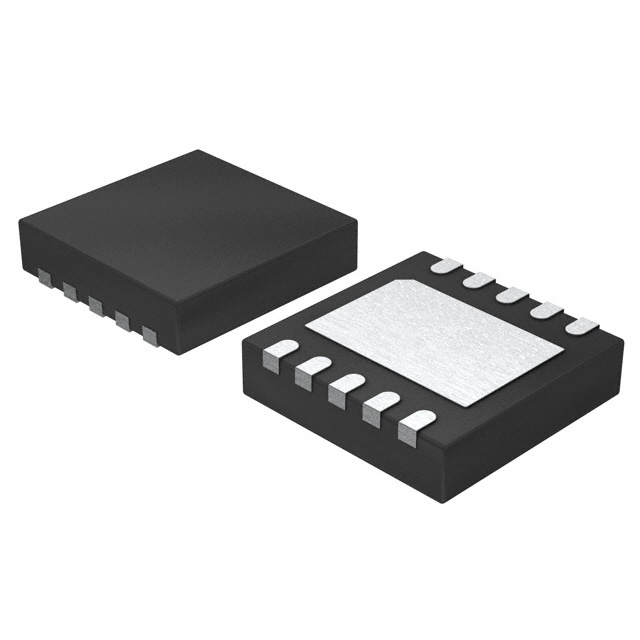Xem thông số kỹ thuật để biết chi tiết sản phẩm.

LTC2616CDD-1#TRPBF
Product Overview
Category
The LTC2616CDD-1#TRPBF belongs to the category of digital-to-analog converters (DACs).
Use
This product is primarily used in applications where a digital signal needs to be converted into an analog voltage or current. It finds extensive use in various industries such as telecommunications, industrial automation, and audio equipment.
Characteristics
- High precision: The LTC2616CDD-1#TRPBF offers exceptional accuracy and resolution, ensuring precise conversion of digital signals.
- Low power consumption: This DAC is designed to operate efficiently with minimal power requirements.
- Fast settling time: The LTC2616CDD-1#TRPBF provides rapid settling time, enabling quick response in dynamic applications.
- Wide operating voltage range: It can operate within a wide range of supply voltages, making it versatile for different system configurations.
Package
The LTC2616CDD-1#TRPBF is available in a compact dual 10-lead DFN package, which ensures ease of integration into various circuit designs.
Essence
The essence of the LTC2616CDD-1#TRPBF lies in its ability to accurately convert digital signals into analog outputs, facilitating seamless communication between digital and analog systems.
Packaging/Quantity
This product is typically packaged in reels, containing a specified quantity of LTC2616CDD-1#TRPBF units per reel. The exact quantity may vary depending on the manufacturer's specifications.
Specifications
- Resolution: 16 bits
- Number of channels: 1
- Interface type: Serial (SPI/I2C)
- Supply voltage range: 2.7V to 5.5V
- Operating temperature range: -40°C to +85°C
- Output voltage range: 0V to VREF
Detailed Pin Configuration
The LTC2616CDD-1#TRPBF features the following pin configuration:
- VDD: Power supply voltage
- GND: Ground reference
- SDA/SCL: Serial data input/output or serial clock input (depending on the interface mode)
- CS: Chip select input
- REF: Reference voltage input
- AGND: Analog ground
- OUT: Analog output
- NC: No connection
- VLOGIC: Logic supply voltage
- VREF: Reference voltage output
Functional Features
- High accuracy: The LTC2616CDD-1#TRPBF offers excellent linearity and low integral non-linearity, ensuring precise analog outputs.
- Programmable output range: It allows users to configure the output voltage range according to their specific requirements.
- Daisy-chain capability: Multiple LTC2616CDD-1#TRPBF devices can be connected in a daisy-chain configuration, simplifying system integration.
- Power-on reset: The DAC automatically initializes to a known state upon power-up, ensuring reliable operation.
Advantages and Disadvantages
Advantages
- High precision and resolution
- Low power consumption
- Fast settling time
- Wide operating voltage range
- Compact package size for easy integration
Disadvantages
- Limited number of channels (single-channel device)
- Requires an external reference voltage source
Working Principles
The LTC2616CDD-1#TRPBF operates based on the principle of digital-to-analog conversion. It receives digital input signals through the serial interface (SPI/I2C) and converts them into corresponding analog voltages. This conversion is achieved by utilizing an internal digital-to-analog converter circuitry, which accurately translates the digital values into precise analog outputs.
Detailed Application Field Plans
The LTC2616CDD-1#TRPBF finds extensive application in various fields, including:
- Telecommunications: Used in communication systems for signal conditioning and modulation purposes.
- Industrial automation: Employed in control systems to convert digital control signals into analog outputs for actuator control.
- Audio equipment: Integrated into audio devices for digital-to-analog conversion of audio signals, ensuring high-quality sound reproduction.
Detailed and Complete Alternative Models
- LTC2600: Similar to the LTC2616CDD-1#TRPBF, this model offers multiple channels for simultaneous conversion of multiple digital inputs.
- AD5628: A comparable DAC with similar specifications and features, suitable for applications requiring high precision and resolution.
In conclusion, the LTC2616CDD-1#TRPBF is a high-precision digital-to-analog converter that offers exceptional accuracy, low power consumption, and fast settling time. It finds application in telecommunications, industrial automation, and audio equipment. While it has some limitations such as a single-channel configuration and the need for an external reference voltage source, alternative models like the LTC2600 and AD
Liệt kê 10 câu hỏi và câu trả lời thường gặp liên quan đến ứng dụng LTC2616CDD-1#TRPBF trong giải pháp kỹ thuật
Sure! Here are 10 common questions and answers related to the application of LTC2616CDD-1#TRPBF:
Q1: What is LTC2616CDD-1#TRPBF? A1: LTC2616CDD-1#TRPBF is a specific model number for a digital-to-analog converter (DAC) chip manufactured by Linear Technology (now part of Analog Devices). It is used to convert digital signals into analog voltages.
Q2: What is the operating voltage range of LTC2616CDD-1#TRPBF? A2: The operating voltage range of LTC2616CDD-1#TRPBF is typically between 2.7V and 5.5V.
Q3: How many channels does LTC2616CDD-1#TRPBF have? A3: LTC2616CDD-1#TRPBF has 16 channels, which means it can simultaneously output 16 different analog voltages.
Q4: What is the resolution of LTC2616CDD-1#TRPBF? A4: LTC2616CDD-1#TRPBF has a resolution of 16 bits, which means it can represent analog voltages with a precision of 1 part in 65,536.
Q5: Can LTC2616CDD-1#TRPBF be controlled using a microcontroller? A5: Yes, LTC2616CDD-1#TRPBF can be controlled using a microcontroller or any other digital interface that supports I2C communication.
Q6: What is the maximum output voltage range of LTC2616CDD-1#TRPBF? A6: The maximum output voltage range of LTC2616CDD-1#TRPBF is determined by the reference voltage applied to its VREF pin. It can be set between 0V and the reference voltage.
Q7: Can LTC2616CDD-1#TRPBF operate in a single-ended or differential mode? A7: LTC2616CDD-1#TRPBF can operate in both single-ended and differential modes, depending on the application requirements.
Q8: What is the typical settling time of LTC2616CDD-1#TRPBF? A8: The typical settling time of LTC2616CDD-1#TRPBF is around 4 microseconds, which means it takes approximately 4 microseconds for the output voltage to stabilize after a change in the digital input.
Q9: Does LTC2616CDD-1#TRPBF have any built-in features for calibration or self-test? A9: No, LTC2616CDD-1#TRPBF does not have any built-in features for calibration or self-test. These functions need to be implemented externally if required.
Q10: Can LTC2616CDD-1#TRPBF be used in automotive applications? A10: Yes, LTC2616CDD-1#TRPBF is suitable for automotive applications as it can operate within the specified temperature range and has low power consumption. However, additional considerations may be required for automotive-specific requirements such as EMI/EMC compliance.
Please note that these answers are general and may vary based on specific datasheet information and application requirements.

